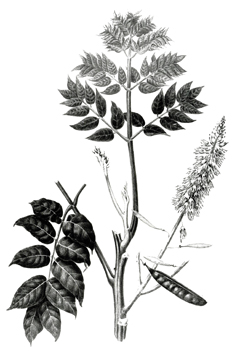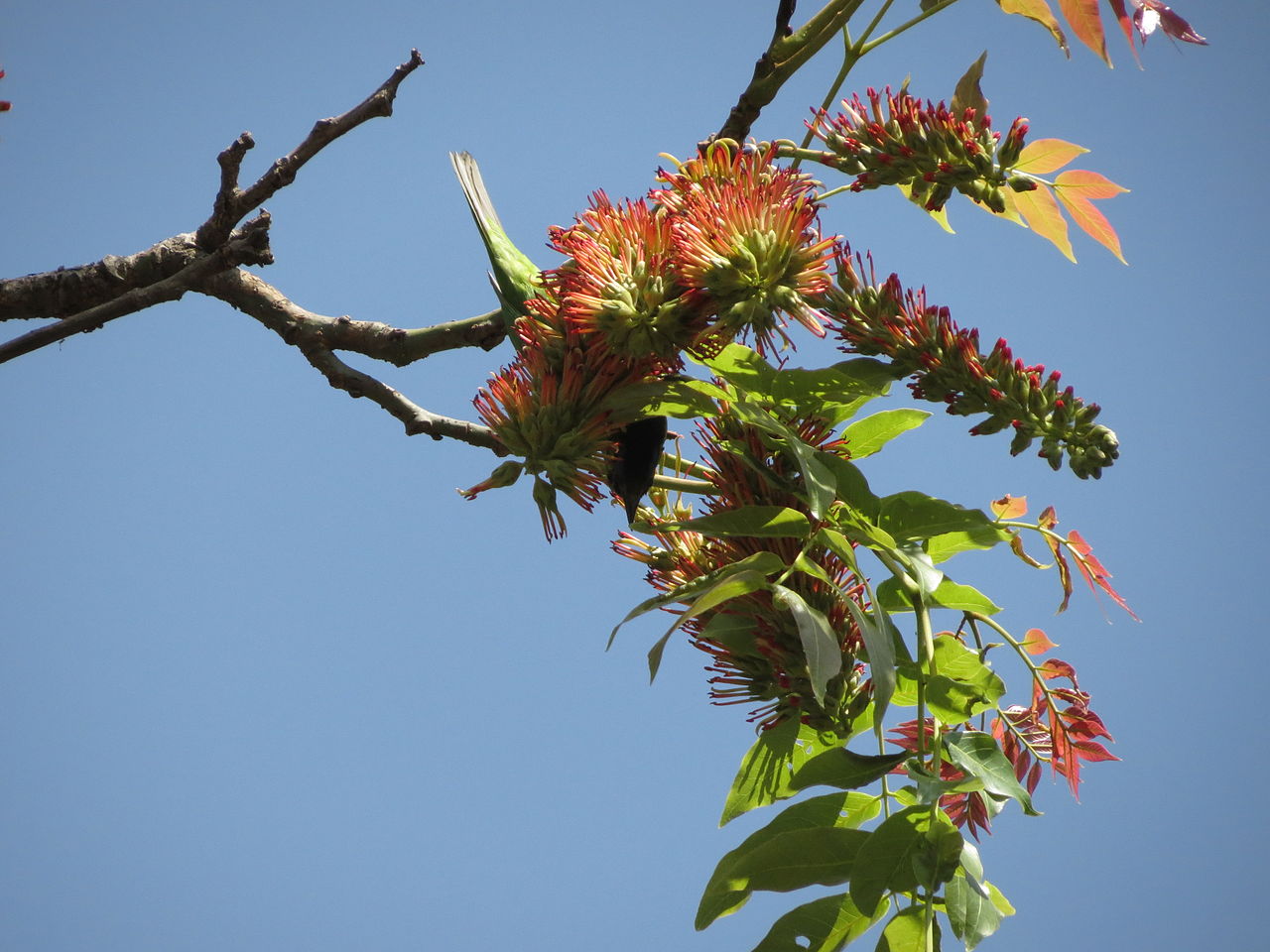 |
|
http://www.edibleplants.org |
 |
| Wikimedia.org User:Forestowlet |
Translate this page:
Summary
Acrocarpus fraxinifolius - Pink Cedar or Shingle Tree, is a large deciduous emergent tree that can reach 60m in the right conditions. Older trees have massive plank buttresses and the stem, light grey and thinly barked, can be over 75% free of branches. Thin horizontal branches. Bi-pinnate leaves with 3-4 compound leaves with 5-6 elliptical, lanceolate leaflets up to 10 cm long and bright red when young. Red-Orange, Pale Green flowers appear on tree when leafless. Fruit is an elongated and flattened pod, long-stipitate, and narrowly winged. Acrocarpus fraxinifolius has very deep roots up to 4.5m. Commonly grown throughout the tropics in plantations for its wood especially in badly degraded areas which are not protected from cattle grazing. It?s used as shade trees in the coffee plantations in India. The timber is recommended for making furniture and cabinets/tea boxes. Acrocarpus fraxinifolius has been identified as one of the food plant for the endangered lion tailed macaque during the period of fruit scarcity.
Physical Characteristics

 Acrocarpus fraxinifolius is a deciduous Tree growing to 30 m (98ft) by 22 m (72ft) at a fast rate.
Acrocarpus fraxinifolius is a deciduous Tree growing to 30 m (98ft) by 22 m (72ft) at a fast rate.
See above for USDA hardiness. It is hardy to UK zone 10 and is frost tender. The flowers are pollinated by Bees, Insects.
It can fix Nitrogen.
It is noted for attracting wildlife.
Suitable for: medium (loamy) soils and prefers well-drained soil. Suitable pH: mildly acid, neutral and basic (mildly alkaline) soils and can grow in very acid and very alkaline soils.
It cannot grow in the shade. It prefers moist soil.
UK Hardiness Map
US Hardiness Map
Synonyms
Acrocarpus combretiflorus Teijsm. & Binn. Acrocarpus grandis (Miq.) Miq. Mezoneurum grande Miq.
Plant Habitats
Edible Uses
Edible Parts:
Edible Uses: Gum
None Known
References More on Edible Uses
Medicinal Uses
Plants For A Future can not take any responsibility for any adverse effects from the use of plants. Always seek advice from a professional before using a plant medicinally.
None Known
References More on Medicinal Uses
The Bookshop: Edible Plant Books
Our Latest books on Perennial Plants For Food Forests and Permaculture Gardens in paperback or digital formats.

Edible Tropical Plants
Food Forest Plants for Hotter Conditions: 250+ Plants For Tropical Food Forests & Permaculture Gardens.
More

Edible Temperate Plants
Plants for Your Food Forest: 500 Plants for Temperate Food Forests & Permaculture Gardens.
More

More Books
PFAF have eight books available in paperback and digital formats. Browse the shop for more information.
Shop Now
Other Uses
Fuel Gum Pioneer Shelterbelt Soil stabilization Wood
Agroforestry Uses: The tree has an extensive root system and has been recommended for reinforcing riverbanks and stabilizing terraces[ 303 ]. A natural pioneer species, it is fast growing and adds atmospheric nitrogen to the soil. It has proved to be very good for the reforestation of open areas[ 303 ]. Its leaf fall adds nutrients and humus to the soil and are suitable for mulching[ 303 ]. It is ideal as a shade tree on tea and coffee plantations[ 303 ]. It is known to have been planted as a windbreak in some areas[ 303 ]. Other Uses The wood exudes a gum-like resin when the trees are felled[ 303 ]. The sapwood is whitish; the heartwood is bright red to brownish-red with darker veins, making it very decorative. The wood is not very durable and is prone to attack by fungi and insects, but it impregnates well[ 303 ]. The grain is straight to slightly interlocked, sometimes wavy; the texture is coarse and even; the is wood is lustrous[ 299 ]. It is heavy, moderately hard, and compact. It is easy to work with tools and is well suited for turnery, carving and polishing[ 303 ]. The wood is used for interior trim, panelling, furniture and cabinet work. Because it splits easily and regularly, it makes excellent roof shingles[ 307 ]. Within its native range it is also used for general construction, floors, stairways, doors, tea crates, beehive frames, and after being impregnated, for railway ties[ 303 ]. The wood is sometimes used for firewood in many places[ 303 ].
Special Uses
Food Forest Nitrogen Fixer
References More on Other Uses
Cultivation details
Acrocarpus fraxinifolius grows best in submontane areas in the humid and subhumid tropics with a short, dry spell[303 ]. It succeeds at elevations from sea level to about 2,000 metres, growing best in areas where the annual precipitation is between 500 - 3,000 mm and the temperature ranges between 15 - 26c[303 ]. Plants are very sensitive to frost[303 ]. Prefers a fertile soil and a position in full sun, though it can tolerate a small amount of shade, especially when young[200 , 303 , 307 ]. Succeeds in acid and alkaline soils[303 ]. A pioneer species, it regenerates primarily in small, burnt areas, on open patches where fresh soil has been exposed and along newly constructed roads[303 ]. Shingle tree is quite fast-growing, able to reach heights of up to 3 metres within 12 months from seed[307 ]. Growth of older trees is still rapid, as observed in Tanzania where the mean annual increment of 13 year old trees was 120cm in height and 19mm in diameter. In Rwanda the mean height of trees was 150cm after 1 year, 4.4 metres after 2 years, 6.7 metres after 3 years, and 19 metres after 24 years with a bole diameter of 35cm[299 ]. A deep rooting plant, the roots can penetrate up to 4.5 metres into the soil[303 ]. It coppices vigorously, the rotation period for fuel is 8 - 10 years and for timber 30 - 40 years[303 ]. The tree competes with crops if grown in fields[303 ]. Young plants have been observed to behave as climbers and stranglers of other trees[307 ]. The tree is a good source of nectar and a good bee forage[303 ]. This species has a symbiotic relationship with certain soil bacteria, these bacteria form nodules on the roots and fix atmospheric nitrogen. Some of this nitrogen is utilized by the growing plant but some can also be used by other plants growing nearby[200 ]."
References Carbon Farming Information and Carbon Sequestration Information
Temperature Converter
Type a value in the Celsius field to convert the value to Fahrenheit:
Fahrenheit:
The PFAF Bookshop
Plants For A Future have a number of books available in paperback and digital form. Book titles include Edible Plants, Edible Perennials, Edible Trees,Edible Shrubs, Woodland Gardening, and Temperate Food Forest Plants. Our new book is Food Forest Plants For Hotter Conditions (Tropical and Sub-Tropical).
Shop Now
Plant Propagation
Seed - pre-soak for 5 minutes in hot water and leave to soak for 24 hours in warm water before sowing in a shaded bed[303 ]. Alternatively, pretreat the seed with sulphuric acid for 10 min[303 ]. A germination of 80 - 95% within only 2 - 7 days is achieved after this pre-treatment[303 ]. Under natural conditions, some seeds may germinate within a week, while others may lie dormant for a year before germinating. Seedlings are ready for planting out when 3 months old and 30 - 45 cm tall[303 ]. The seedlings are pricked out into beds or containers and placed in full sunlight[303 ]. From the beds they can be planted bare-rooted or as stumps or striplings[303 ]. Seeds exhibit orthodox storage behaviour; they should be stored at low temperatures. A few seeds survived 7 years of storage at room temperature[303 ]. Patch budding has been used and 80% success recorded during establishment seed orchards[303 ].
Other Names
If available other names are mentioned here
It is also known as Indian Ash, Australian Ash, Kenya Coffeeshade, Mundani (Bengali), Red Cedar. Other names include: Mayahnin,Yetama (Burmese); Kuranjan
(French); Belanji, Hevulige, Kuranjan, Malankommao, Silchhal (Hindi);
Madang Pariek, Delimas (Indonesian); Delimas (Javanese); Khan Khak, Ket ?Hoy (Lao); lazcar,cedro rosado (Spanish); khang chang,sadao chang,khang khi mot (Thai); Trade name: Mundani
Native Plant Search
Search over 900 plants ideal for food forests and permaculture gardens. Filter to search native plants to your area. The plants selected are the plants in our book 'Plants For Your Food Forest: 500 Plants for Temperate Food Forests and Permaculture Gardens, as well as plants chosen for our forthcoming related books for Tropical/Hot Wet Climates and Mediterranean/Hot Dry Climates. Native Plant Search
Found In
Countries where the plant has been found are listed here if the information is available
Weed Potential
Right plant wrong place. We are currently updating this section.
Please note that a plant may be invasive in one area but may not in your area so it’s worth checking.
Conservation Status
IUCN Red List of Threatened Plants Status : This taxon has not yet been assessed.

Growth: S = slow M = medium F = fast. Soil: L = light (sandy) M = medium H = heavy (clay). pH: A = acid N = neutral B = basic (alkaline). Shade: F = full shade S = semi-shade N = no shade. Moisture: D = dry M = Moist We = wet Wa = water.

Expert comment
Author
Arn.
Botanical References
Links / References
For a list of references used on this page please go here
Readers comment
| Add a comment |
|
If you have important information about this plant that may help other users please add a comment or link below. Only comments or links that are felt to be directly relevant to a plant will be included. If you think a comment/link or information contained on this page is inaccurate or misleading we would welcome your feedback at [email protected]. If you have questions about a plant please use the Forum on this website as we do not have the resources to answer questions ourselves.
* Please note: the comments by website users are not necessarily those held by PFAF and may give misleading or inaccurate information.
To leave a comment please Register or login here All comments need to be approved so will not appear immediately.
|
Subject : Acrocarpus fraxinifolius
|
|
|
|